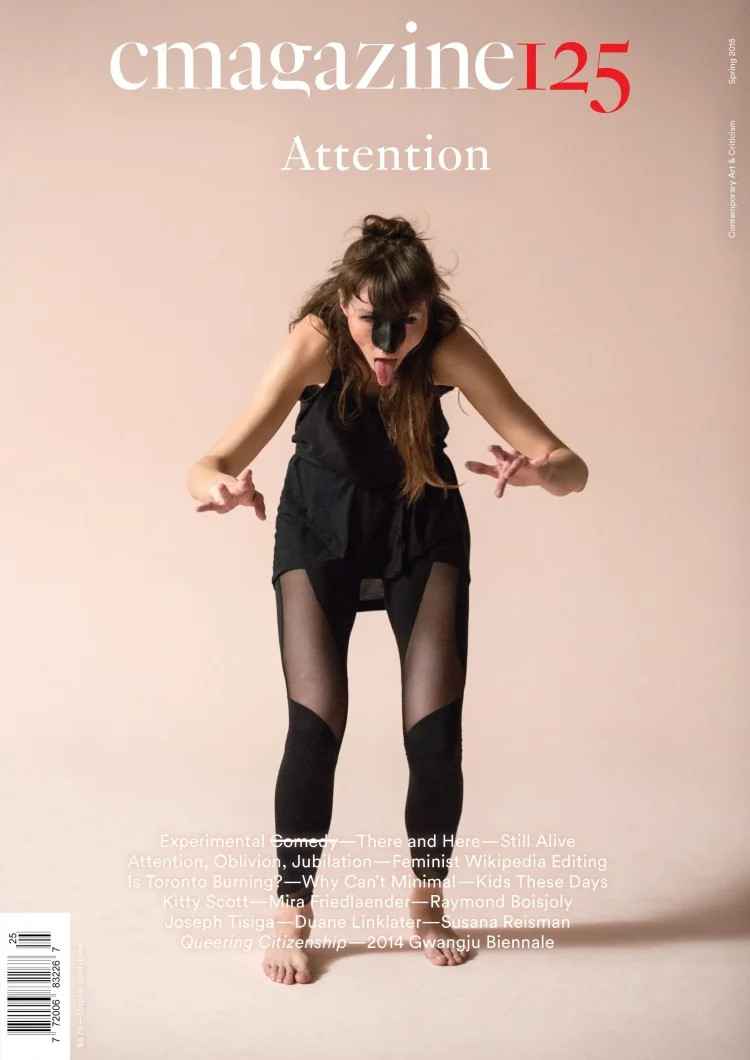View full issue here.
C Magazine Issue 125: Attention
Spring 2015
Attention
Over the past few months, there have been a number of exciting changes at C Magazine. We created a new Assistant Editor position, filled by Kari Cwynar, and initiated a new Editorial Advisory Committee. Together we’ve begun planning forthcoming issues on themes including the idea of art world elders or “predecessors” and poetry within visual art, as well as on citizenship, documentation, feminism and materialism, and hospitality. Not every article in an issue, however, needs to focus on a given theme. And themes typically evolve in dialogue with our writers and artist contributors, meaning that we are open to other ideas and that you’ll continue to see a range of different kinds of content in each issue.
This particular issue addresses a number of different emergent practices within contemporary art, from new forms of still life to performance art that employs the conventions of stand-up comedy. Among the ideas that appear within these pages is that of attention, which functions as an imperative or directive, and is the topic of one of the feature essays. Writing about the video and performance art of Jeremy Shaw, Godfre Leung looks at attention as a quantifiable commodity in contemporary economic life, where work and leisure often become indistinct. As a magazine targeted largely at arts professionals, who also participate in the art world outside their regular workdays, this collapsing of leisure and labour is particularly pronounced for us, mirroring the conditions of many other people within today’s society.
Practices of erasure and insertion also form a meta-theme for this issue, which is employed by a number of our artists and writers. For our regular On Writing column, Sarah Butterill, Amy Furness, Ella Dawn McGeough and Zeesy Powers document their process of staging Art + Feminism Wikipedia edit-a-thons at various venues in Toronto, through which they address the under-representation of women artists on Wikipedia. Also employing Wikipedia, Duane Linklater inserted himself into the entry for Cape Spear, Newfoundland, North America’s most easterly point, editing the page to indicate that he was the first person on the continent to see the sun rise on March 10, 2011. A photograph of the sunrise on that day, and the discussion that ensued on the editing page for Cape Spear appear in the Artefact section. And dealing with ideas of erasure and transformation, Raymond Boisjoly’s artist project, titled From age to age, as its shape slowly unraveled… involved taking a scan of a video of the 1953 film Statues Also Die. Here, he foregrounds the translation of form and content; the film print is digitized and redigitized, such that it is almost unrecognizable, its meaning shifted and destabilized.
Literally erasing comedy from how we think about performance art that employs the conventions of stand-up, Kari Cwynar writes about Ieva Misevičiūtė and Michael Portnoy’s Experimental Comedy Training Camp residency held at The Banff Center for the Arts in 2012, as well as Doored, a performance series in Toronto. Cwynar argues that this work borrows the structure of comedy without producing humour for its own sake, as a practice of formal experimentation that engages and develops the performer-audience relationship. While it might be funny, it’s less about comedy than it appears on the surface.
Both of the artist projects in this issue provide an apt metaphor for an art magazine’s task of reflecting the current state of contemporary art. Both Raymond Boisjoly and Duane Linklater attempt to capture something that unfolds in time: a film being screened and a sunrise. By representing their processes they reveal the impermanence and mutability of the objects they capture. Similarly, publishing an art magazine means trying to capture ideas and practices that are always in flux. This issue seeks to expose and intervene within that process, finding an elusive moment of pause and reflection on an ever-shifting horizon.
